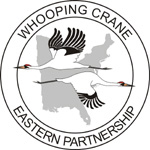| ICF’s Eva Szyszkoski (below), Tracking Field Manager for the Whooping Crane Eastern Partnership (WCEP), has been in Alabama banding the group of nine ultralight-led Whooping Cranes, which were released at Wheeler National Wildlife Refuge earlier this month (view photos from the banding and learn more about the cranes’ release in Alabama). Last week, Eva was tracking a tenth Whooping Crane (#2-11), who had separated from the other nine juvenile cranes during migration in Wisconsin last October and wintered in Florida. Following is Eva’s report on her attempt to re-capture #2-11 to replace it’s radio transmitter (and news that spring migration has started!). It wasn’t until a week later when a local birder reported a single juvenile Whooping Crane with a flock of Sandhills, just north of the ultra-light led Whooping Crane’s Wisconsin summer training sight, that we finally had an answer. Number 2-11’s snap-on transmitter had indeed failed, at perhaps the most coincidental time ever…while she was actively being tracked. After an unsuccessful attempt to capture her, she was considered officially released and remained in the area through at least November 6th. On the 19th, she was seen and photographed at Lake Allatoona in northern Georgia and had successfully completed migration to Lake County, Florida, by November 27th, where she joined another wintering Whooping Crane, female #10-10, and some Sandhill Cranes. On February 13th (after a lot of travel to and from Alabama to band the rest of the ultra-light led juveniles), Ben Weiss (Bio Tech) and Olivia Bailey (intern) from the Crystal River National Wildlife Refuge and I headed down to Lake County to attempt to capture #2 to affix her permanent transmitter and bands. When we arrived, the two Whooping Cranes were happily feeding alone in a pasture, but by the time we had donned our crane costumes and filled up baggies with treats, the two had been joined by a number of Sandhill Cranes. For the next few hours we tried to approach the group, but #2-11 hopped around from pasture to pasture with the Sandhills and #10-10, would not allow us to get close enough to her to use the treats. Meanwhile, the cows in each pasture exhibited their curiosity (or terror?) at the three unfamiliar, white-clad, figures on their turf by stampeding around, occasionally stopping to stare, and then stampeding to a new location to stop and stare again. This, obviously, didn’t help settle the cranes down much.  Finally, #2-11 separated from #10-10 and the majority of the Sandhills. As she fed in a new pasture with 5 to 6 Sandhills, we (Ben, Olivia and myself) set up shop in a nearby field and tried to look as interesting as possible…poking around at the ground, jabbing at corn cobs, using our mp3 player to play a recorded Whooping Crane brood call, you name it. Our plan was to see if #2-11 would come to us, since chasing her and the Sandhills around clearly wasn’t working. She wasn’t interested. Then, for no apparent reason, she and her small group of Sandhills took to the air. It wasn’t long before #10-10 flew up to join the group, calling as she came. As we watched, the group began to climb on thermals. Eventually the Sandhills started descending and landed back in the pasture, but the two Whooping Cranes continued to circle until finally heading to the southeast towards a location where they had been roosting. Obligingly, Ben, Olivia and I followed their progress with my tracking van. For about an hour they circled around the roosting marshes until I got a glimpse of them, still without any Sandhills, heading back towards the farm. I drove back to the farm to wait for them to arrive, which, based on #10-10’s signal, they did…to a point. And then the signals started getting fainter and fainter to the north. I tracked them until they were 50 miles north of their wintering location and decided that they were indeed leaving on spring migration. On February 16, I received a call from a local birdwatcher at the Hiwassee Wildlife Refuge in Tennessee. He described seeing a Whooping Crane with no bands on the left leg and what appeared to be a large black band on the right – #2-11! Now we will have to wait for another capture opportunity to present itself, but without the ability to track her and with no previous summering history, that chance may not occur for a while! There are still four Whooping Cranes at the Hiwassee Wildlife Refuge, two juvenile Direct Autumn Release birds and two older birds (also both from the Direct Autumn Release program). |

|


